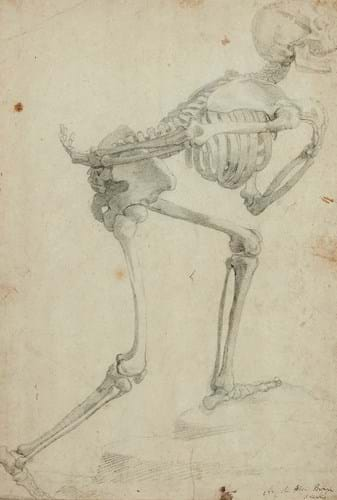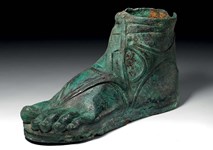It was catalogued as ‘attributed to’ Agnolo di Cosimo (1503-1572), the Florentine mannerist known as Bronzino. Another candidate for authorship was Bronzino’s pupil Allesandro Allori (1535-1607) who, after the early death of his father, was effectively adopted by Bronzino and often referred to him affectionately as his uncle.
For over half a century, this drawing of a walking skeleton had been in a German collection, bought at an auction in Lucerne in 1964. It came up for sale at Lempertz (25% buyer’s premium) in Cologne on May 30.
The black chalk drawing measured 16 x 11in (40 x 28cm) and an inscription to the lower right corner appears to read Angolo Allori Bronzino il vecchio.
The catalogue described the drawing as ‘Inscribed lower right: Agnolo Bronzino il vecchio...’ and ‘Inscribed on the reverse: Angnolo Bronz Vecchio (...)’. According to the catalogue, this older ‘signature’ (that on the bottom right) was probably a later addition by an unknown hand and a watermark (of a crossbow and a small lily) shows that the paper originates from the 16th century, as it was used in Florence and Ferrara during this time.
The guide was a highly speculative €3000-3500.
However, between the publication of the catalogue and auction day, several connoisseurs recognised the style of the drawing as that of Bronzino’s pupil Alessandro Allori (1535-1607), one of the most prolific painters in late 16th century Florence.
Dealers and collectors from several countries, among them 15 on the phones, joined in the fray. In next to no time, bidding went into five figures, then to six figures, until the hammer fell at €420,000 (£381,820), bid by the French dealer.
The auction house said that when the drawing was sold in 1964 in Lucerne it was catalogued as a work by Il Bronzino.
Due to the fact that all libraries and institutes with the relevant reference books were closed due to coronavirus, it had no chance to research the matter fully and decided to err on the side of caution by putting it in the catalogue as an attributed work.
















